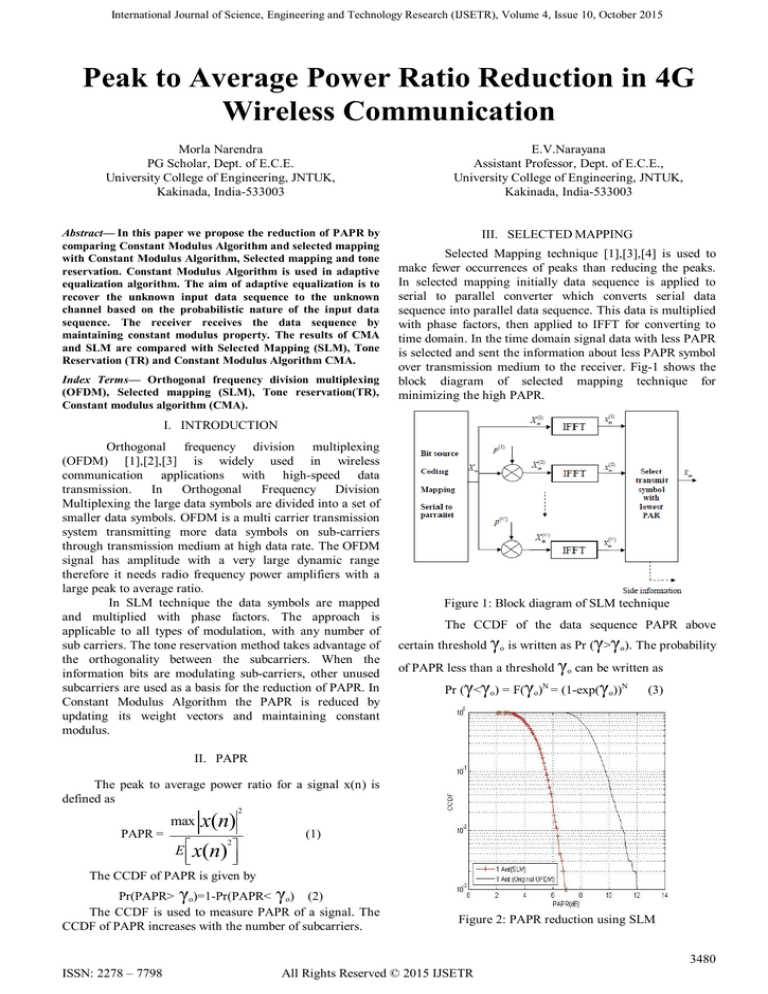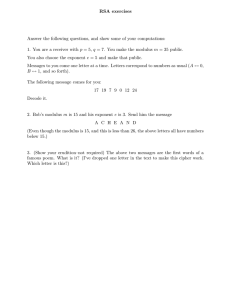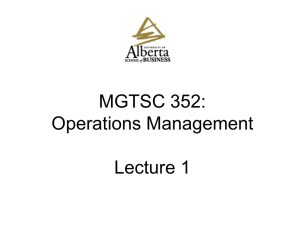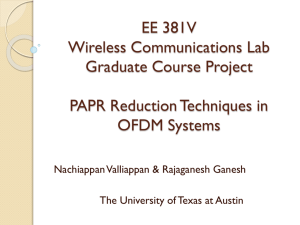
International Journal of Science, Engineering and Technology Research (IJSETR), Volume 4, Issue 10, October 2015
Peak to Average Power Ratio Reduction in 4G
Wireless Communication
Morla Narendra
PG Scholar, Dept. of E.C.E.
University College of Engineering, JNTUK,
Kakinada, India-533003
Abstract— In this paper we propose the reduction of PAPR by
comparing Constant Modulus Algorithm and selected mapping
with Constant Modulus Algorithm, Selected mapping and tone
reservation. Constant Modulus Algorithm is used in adaptive
equalization algorithm. The aim of adaptive equalization is to
recover the unknown input data sequence to the unknown
channel based on the probabilistic nature of the input data
sequence. The receiver receives the data sequence by
maintaining constant modulus property. The results of CMA
and SLM are compared with Selected Mapping (SLM), Tone
Reservation (TR) and Constant Modulus Algorithm CMA.
Index Terms— Orthogonal frequency division multiplexing
(OFDM), Selected mapping (SLM), Tone reservation(TR),
Constant modulus algorithm (CMA).
E.V.Narayana
Assistant Professor, Dept. of E.C.E.,
University College of Engineering, JNTUK,
Kakinada, India-533003
III. SELECTED MAPPING
Selected Mapping technique [1],[3],[4] is used to
make fewer occurrences of peaks than reducing the peaks.
In selected mapping initially data sequence is applied to
serial to parallel converter which converts serial data
sequence into parallel data sequence. This data is multiplied
with phase factors, then applied to IFFT for converting to
time domain. In the time domain signal data with less PAPR
is selected and sent the information about less PAPR symbol
over transmission medium to the receiver. Fig-1 shows the
block diagram of selected mapping technique for
minimizing the high PAPR.
I. INTRODUCTION
Orthogonal frequency division multiplexing
(OFDM) [1],[2],[3] is widely used in wireless
communication applications with high-speed data
transmission.
In
Orthogonal
Frequency Division
Multiplexing the large data symbols are divided into a set of
smaller data symbols. OFDM is a multi carrier transmission
system transmitting more data symbols on sub-carriers
through transmission medium at high data rate. The OFDM
signal has amplitude with a very large dynamic range
therefore it needs radio frequency power amplifiers with a
large peak to average ratio.
In SLM technique the data symbols are mapped
and multiplied with phase factors. The approach is
applicable to all types of modulation, with any number of
sub carriers. The tone reservation method takes advantage of
the orthogonality between the subcarriers. When the
information bits are modulating sub-carriers, other unused
subcarriers are used as a basis for the reduction of PAPR. In
Constant Modulus Algorithm the PAPR is reduced by
updating its weight vectors and maintaining constant
modulus.
Figure 1: Block diagram of SLM technique
The CCDF of the data sequence PAPR above
certain threshold γo is written as Pr (γ>γo). The probability
of PAPR less than a threshold γo can be written as
Pr (γ<γo) = F(γo)N = (1-exp(γo))N
(3)
II. PAPR
The peak to average power ratio for a signal x(n) is
defined as
max
PAPR =
x(n)
2
2
E x(n)
(1)
The CCDF of PAPR is given by
Pr(PAPR> γo)=1-Pr(PAPR< γo) (2)
The CCDF is used to measure PAPR of a signal. The
CCDF of PAPR increases with the number of subcarriers.
Figure 2: PAPR reduction using SLM
3480
ISSN: 2278 – 7798
All Rights Reserved © 2015 IJSETR
International Journal of Science, Engineering and Technology Research (IJSETR), Volume 4, Issue 10, October 2015
In this case, the probability of PAPR greater than
γo is equals to the product of each independent probability.
This process can be written as
Pr{PAPR>
γo }=(P{PAPR> γo })M=(1-(1-exp(-γo))N) (4)
The adaptive equalization performs on data without
reference to data signal. Instead, the adaptive equalization
relies on the knowledge of the signal structure and its
probabilistic nature to perform equalization. The source is
unknown but has constant modulus:
s
k
=1for all k.
IV. TONE RESERVATION
In Tone Reservation [2],[3],[5], tones are used for
reducing PAPR. These tones do not carry any information
and used for peak reduction. This restricts the data vector X,
and the tone vector C to lie in different frequency subspaces.
(5)
The subset of used tones are denoted by L={i0,.. iL}
with L N, where N represent the set of all tones in the
multi carrier symbol LC is the complement of L in N and
represent information carriers. The addition of these
reserved tones c to a data-bearing signal x a new composite
signal
x n = x[n]+c[n]=IFFT (XK+CK) (6)
Since symbol demodulation is performed in the
frequency domain on a tone-by-tone basis, the reserved subchannels can be discarded at the receiver, and only the databearing sub-channels are used to determine the transmitted
bit stream. The PAPR becomes
PAPR =
max
x(n)c(n)
Ex(n)
Figure 4: PAPR reduction using CMA
In CMA we use cost function and weight vector for
minimizing modulus variation. Figure 5 shows CCDF of
constant modulus algorithm.
2
(7)
2
The PAPR can be reduced by optimizing c(n) so that
max
x(n) c(n)
2
can be smaller than max
x(n)
2
.
Figure 5: PAPR reduction using CMA
VI. PRAPOSED WORK (CMA+SLM)
Figure 3: PAPR reduction using TR
V. CMA
PAPR is reduced in CMA, but further reduction is
possible by combining Constant Modulus algorithm with
scrambling technique Selected Mapping (SLM). In selected
mapping (SLM) method phase factors are used for making
fewer occurrences of peaks than reducing peaks. In this
technique no side information is required.
The receiver is synchronized to the received signal and
adjusted to the equalizer without training sequence. The
Constant Modulus Algorithm is employed for the Adaptive
Equalization. In CMA source is unknown but source has
constant modulus:
Equalization is used to correct frequency distortion
in communication system. Constant Modulus Algorithm
[6],[7],[8] is used in adaptive equalizer. Many modulation
techniques like FM, PM, FSK, PSK have constant modulus.
The Constant Modulus Algorithm is efficient adaptive
equalization algorithm and it is used in many applications
because it is not required carrier synchronization.
s
= 1 for all k. Many communication
k
signals have the constant modulus (CM) property: FM, PM,
FSK, PSK,... by using this constructed a receiver weight
vector w such that
yk = WH xk =
sˆ
k
where WH is weight factor.
3481
ISSN: 2278 – 7798
All Rights Reserved © 2015 IJSETR
International Journal of Science, Engineering and Technology Research (IJSETR), Volume 4, Issue 10, October 2015
In this work PAPR is reduced by maintaining low BER.
In CMA with SLM technique cost function and weight
vector are used for minimizing modulus variation. Figures-6
and 7 show the comparison of CCDF, BER of CMA and
SLM with Constant Modulus algorithm, Selected Mapping,
Tone Reservation and Original OFDM.
Figure 6: Comparison of CCDF
REFERENCES
[1] Han and Lee, “An overview of peak-to- average power ratio reduction
techniques for multicarrier transmission,” IEEE WirelessCommun. Mag.,
vol. 12, pp. 56–65, Apr. 2005.
[2]Suverna Sengar, Partha Pratim Bhattacharya, “performance improvement
in ofdmsystem by papr reduction,” Signal & Image Processing: An
International Journal (SIPIJ) Vol.3, No.2, April 2012.
[3] V. Vijayarangan, DR. (MRS) R. Sukanesh” An overview of techniques for
reducing peak to average power ration and its selection criteria for
orthogonal frequency division multiplexing radio systems”, Journal of
Theoretical and Applied Information Technology.
[4] Bauml, Fischer, and Huber, “Reducing the peak to average power ratio of
multi carrier modulation by selected mapping”, IEEE Electronics Letters,
Vol.32, Oct 1996.
[5] Umar Izaz Butt, “A Study on Tone Reservation Technique for Peak to
average power ratio Reduction in Orthogonal frequency division
multiplexing”, Year 2010 Dissertation .Com Boca Raton, Florida ISBN-10:159942-360-X, ISBN-13: 978-1-59942-360-9Thesis.
[6] Y. Shen and E. Martinez, “WiMAX channel estimation: Algorithmsand
implementations,” Application Note, Freescale, 2007.
[7] S. Khademi, A.-J. van der Veen, and T. Svantesson, “Precoding
techniquefor peak-to-average-power-ratio (PAPR) reduction in MIMO
OFDM/A systems,” in , 2012 IEEE Int. Conf. Acoustics, Speech andSignal
Processing (ICASSP), Mar. 2012, pp. 3005–3008.
[8] Treichler and Agee, “A approach to multipath correction of constant
modulus signals,” IEEE Trans. Acoust., Speech, SignalProcess., vol. 31, pp.
459–471, Apr. 1983.
M Narendra received
B.Tech
degree
in
Electronics
and
Communication Engineering from
GVPCOE, Vizag, India in the year
2012. Currently pursuing his
master’s degree program in
computers and Communication
engineering in UCEK, JNTUK,
Kakinada, India.
EV Narayana received BE and ME
degrees from college of engineering,
Andhra University, Visakhapatnam.
He started his career as lecturer in
1985. Now he is working as assistant
professor in the department of ECE
College of engineering; JNTUK,
Kakinada. He published 63 papers in
national
and
international
conferences and journals.
Figure 7: BER of SLM, TR, CMA, CMA+SLM
VI. CONCLUSION
In this paper compared the different PAPR
reduction techniques like constant modulus algorithm with
selected mapping, constant modulus algorithm, tone
reservation and selected mapping. The PAPR is smallest in
constant modulus algorithm with selected mapping. Figure
7 showed that BER is lowest in our work when compared
with other techniques.
3482
ISSN: 2278 – 7798
All Rights Reserved © 2015 IJSETR






